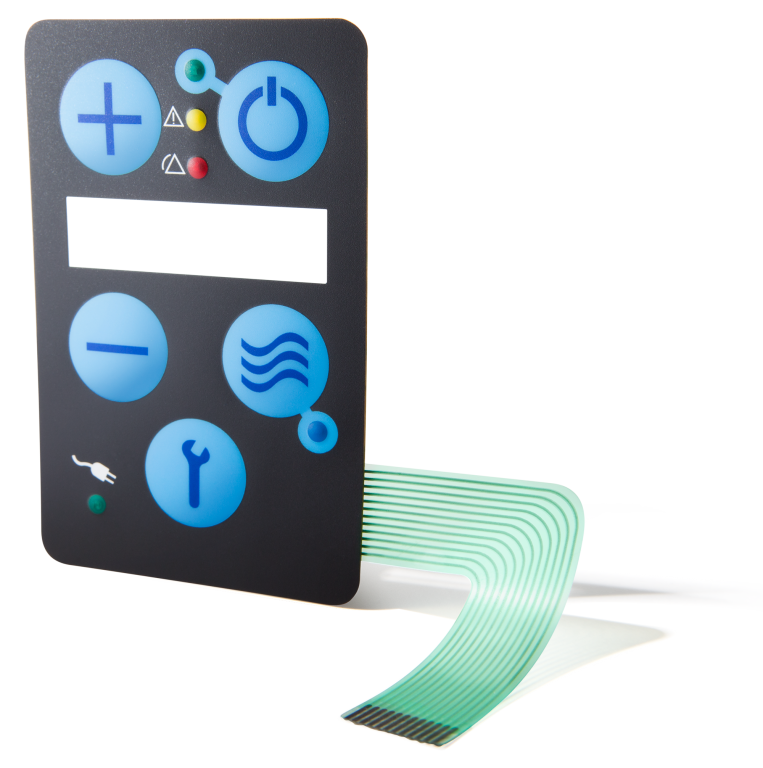How Membrane Switch Technology is Revolutionizing User Interfaces
Recognizing Membrane Switches: The Trick to Trusted and resilient Controls

What Are Membrane Buttons?
Membrane layer buttons are a sophisticated service in the world of interface technology, combining performance and style flawlessly. These devices act as a user interface between individuals and digital systems, incorporating numerous elements into a small style. Typically constructed from flexible, thin layers of materials, membrane layer buttons are made to reply to touch, enabling users to interact with equipment and digital tools properly.
The key aspects of a membrane layer switch include a printed circuit layer, visuals overlay, and a spacer layer that protects against unplanned activation. The visuals overlay can be personalized to show brand identification or customer choices, improving appearances while making certain use. Membrane layer switches are commonly utilized in various applications, consisting of clinical devices, consumer electronic devices, and industrial equipment, owing to their resilience and resistance to environmental variables such as dampness and dust.
One of the key benefits of membrane layer buttons is their capability to stand up to deterioration, making them optimal for high-traffic environments. In addition, they are light-weight and need minimal room, permitting for innovative styles in product advancement. Overall, membrane layer changes stand for a functional and efficient selection for modern digital interfaces, weding technology with user-centric style principles.
Exactly How Membrane Layer Changes Job
The procedure of membrane changes joints on a straightforward yet effective system that equates customer input right into electronic signals. When an individual presses the switch, the leading layer flaws, enabling a conductive aspect in the circuit layer to make call with a corresponding conductive pad on the underside of the graphic overlay.
The style of membrane layer buttons can differ, yet they frequently integrate domes or tactile aspects to give responses to the customer, enhancing the overall experience - membrane switch. The materials used in membrane switches, such as polyester or polycarbonate, add to their sturdiness and resistance to ecological variables, consisting of dampness and dirt. The published circuits are commonly enveloped, which shields them from wear and tear over time.
Benefits of Membrane Switches

Additionally, membrane switches are known for their toughness. Created from robust products, they are resistant to dust, wetness, and physical wear, which significantly extends their lifespan compared to conventional mechanical switches. This sturdiness makes them especially appropriate for high-traffic atmospheres and applications needing durability.
One more considerable benefit is the ease of cleaning and upkeep. The smooth surface area of membrane layer changes lessens dust accumulation and is frequently invulnerable to spills, making them optimal for settings that require constant sanitization.
In addition, membrane layer switches provide a streamlined account, causing a thinner style that can be integrated right into numerous gadgets without adding mass. This function not only enhances the visual charm but additionally adds to a much more ergonomic product layout.
Applications of Membrane Switches
Functional and easy to use, membrane layer switches locate applications throughout a wide variety of markets, including clinical gadgets, consumer electronic devices, and industrial tools. In the clinical field, these buttons are important to devices such as analysis devices, patient surveillance try this website systems, and infusion pumps, where integrity and simplicity of cleansing are vital. Their ability to keep and endure rough atmospheres capability makes them optimal for such applications.

In customer electronic devices, membrane switches are made use of in products like microwaves, washing equipments, and remote controls - membrane switch. Their smooth layout enables user-friendly customer interfaces, enhancing the general customer experience while offering longevity and resistance to tear and use
Commercial tools also profits from membrane switches, particularly in control panels for equipment and automation systems. These buttons offer security versus dirt and dampness, guaranteeing constant efficiency in tough environments. Additionally, their adjustable functions permit suppliers to tailor them to specific operational needs, improving effectiveness and performance.
Choosing the Right Membrane Switch Over
When selecting a membrane layer button, it is vital to take into consideration numerous variables that affect performance and suitability for specific applications. The primary factors to consider consist of environmental conditions, tactile responses, longevity, and layout specs.
First, examine the operating atmosphere; switches revealed to wetness, chemicals, or extreme temperatures call for certain materials to guarantee longevity and capability. Next off, assess the demand for responsive feedback. Depending on customer interaction, some applications may take advantage of a tactile feedback to verify activation, while others may favor a non-tactile style for visual factors.
Toughness is another critical aspect; membrane buttons ought to be made to stand up to frequent usage, impacts, and abrasion. Make sure the chosen button can withstand the anticipated lifecycle, especially in high-usage circumstances.

Final Thought
In conclusion, membrane switches over offer as vital parts in the design of long lasting and reliable control systems across various markets. The convenience of membrane switches enables for customized remedies that meet specific operational requirements, strengthening their value in modern technology.
Membrane hop over to these guys changes represent Find Out More an essential facet of modern interface design, blending functionality with durability in different applications.Membrane switches are an advanced option in the world of customer interface modern technology, combining functionality and design seamlessly. Generally constructed from flexible, thin layers of materials, membrane switches are designed to react to touch, making it possible for customers to connect with equipment and digital gadgets successfully.
The style of membrane layer buttons can differ, however they commonly integrate domes or tactile elements to provide responses to the customer, improving the general experience.In final thought, membrane switches over offer as vital elements in the design of trusted and long lasting control systems across various sectors.